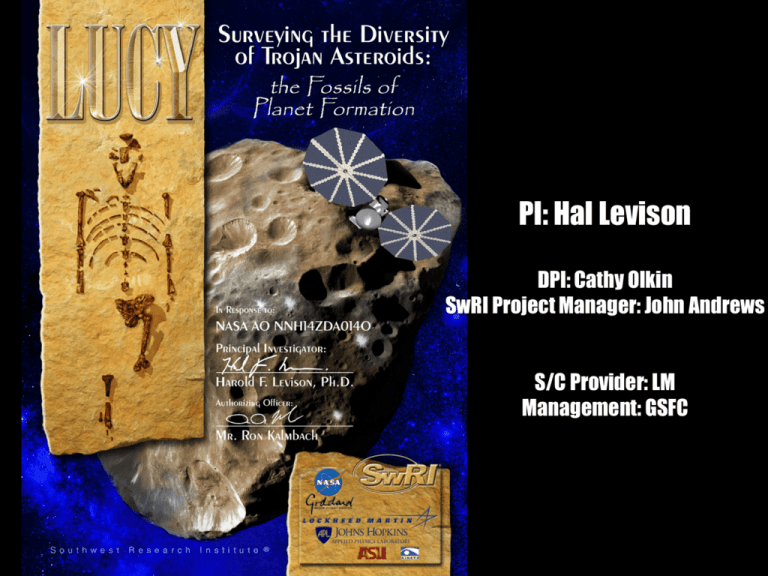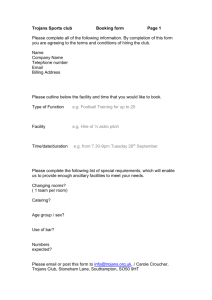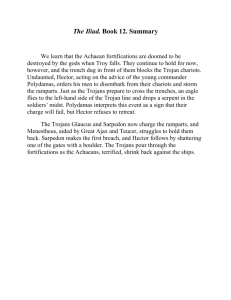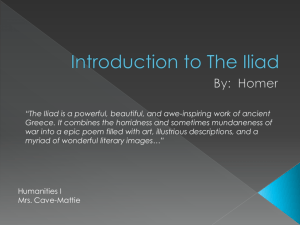Lucy - Surveying the Diversity of Trojan Asteroids
advertisement

PI: Hal Levison DPI: Cathy Olkin SwRI Project Manager: John Andrews S/C Provider: LM Management: GSFC • Lucy is a Trojan asteroid tour called for in Decadal Survey It will perform flybys of 5 Trojans (includes SEO). • Its strengths are: High science return from never before encountered objects. Low risk mission – high heritage. Low cost mission – costs fit comfortably within AO constraints. Timely – unique opportunity in launch window gets multiple highvalue Trojans. • 2021 launch, encounters from 2025-2032. 2 Science Motivation and Complications • To boldly go where no one has gone before. • Compare all Trojans types. Contain C-, D-, and P-type spectral types. • Trojans present us with a UNIQUE opportunity To study Cs, Ds, and Ps in the same environment Constrain planet migration models Ds and Ps are more primitive then Cs They likely formed at different locations Were mixed together by planet formation and migration (DeMeo et al.) Trojans likely harbor objects that formed throughout the outer Solar System. It is only by sampling their complete diversity that their true scientific potential can be realized. 3 We have found a trajectory that visits 5 Trojans and 1 MBA 4 - All known spectral types - Both the L4 and L5 swarms - All known spectral types - Both the L4 and L5 swarms The Mystery of Asteroid Families (3548) Eurybates is the largest member of the only major disruptive collisional family. • We have never visited such an object before. • Will give unique insight into collisional processes (Broz et al.) •Eurybates is a C-type?!? • Rare in the Trojans. • No D-type families in asteroid belt. • Perhaps D’s disintegrate when hit. • Perhaps D’s become C’s when hit. • Lucy will help understand this. 7 - All known spectral types - Both the L4 and L5 swarms - Disruptive collision remnant The Perfect Couple (3548) Eurybates (21900) 1999 VQ10 H 9.8 9.9 D 64 km 51 km P rot 8.7 hr 13.5 hr e 0.09 0.04 i 8.1 deg 8.5 deg type C Likely D pv 0.05 0.08 Color gray red 9 - All known spectral types - Both the L4 and L5 swarms - Disruptive collision remnant Piece de Resistance We have been amazingly lucky and found multiple other targets that make this a much richer mission! (617) Patroclus and Menoetius H 8.2 D 141 km & 112 km P rot 4.3 days e 0.14 i 22 deg type P(!) 11 The Mystery of Equal Mass Binaries >>75% of Cold Classical KBOs are equal mass binaries oMost undisturbed population in the Solar System. • Most objects formed this way? oTheir formation is a mystery. • Classical ideas don’t work. • Most successful idea relies on pebble accretion. o (617) Patroclus is very similar. • It will give insight into how these things came to be. 12 We will also be able to go to these objects. (11351) 1997 TS25 (52246) 1981 EQ5 Trojan Primitive Main Belt Asteroid (used as test of s/c and instruments) H 10.7 15.2 D 34 km 3.9 km a 5.2 AU 2.4 AU e 0.07 0.19 i 11.6 deg 4.4 deg type ? Likely C pv 0.08 0.1 (TS25 is an SEO to give us excellent mass margins) 13 EQ5 is not Just Another Pretty Face 1981 EQ5 is a member of the ~100Myr Erigone family •We will get to see a young surface. • Fresh craters will help us understand collisional evolution of AB. • It will constrain space weathering. • Will help us understand the Yarkovsky forces. 14 Payload L’Ralph Color visible imager and infrared imaging spectrometer Heritage: NH, O’REX L’LORRI High spatial resolution visible imager Heritage: NH Radio Science L’TES Point FTIR spectrometer Heritage: O’REX, MGS No payload hardware Radio science experiment to derive mass from Doppler measurements Team Experience: Rosetta & New Horizons 15 Pan: to 6m/px resolution NIR spectra: 1 – 3.6 microns to 77 m/px 4 band color: to 33 m/px TIR spectra: 6 – 100 microns to 8 km/px 16 - All known spectral types - Both the L4 and L5 swarms - Near-equal mass binary - Disruptive collision remnant - Very young MBA.




